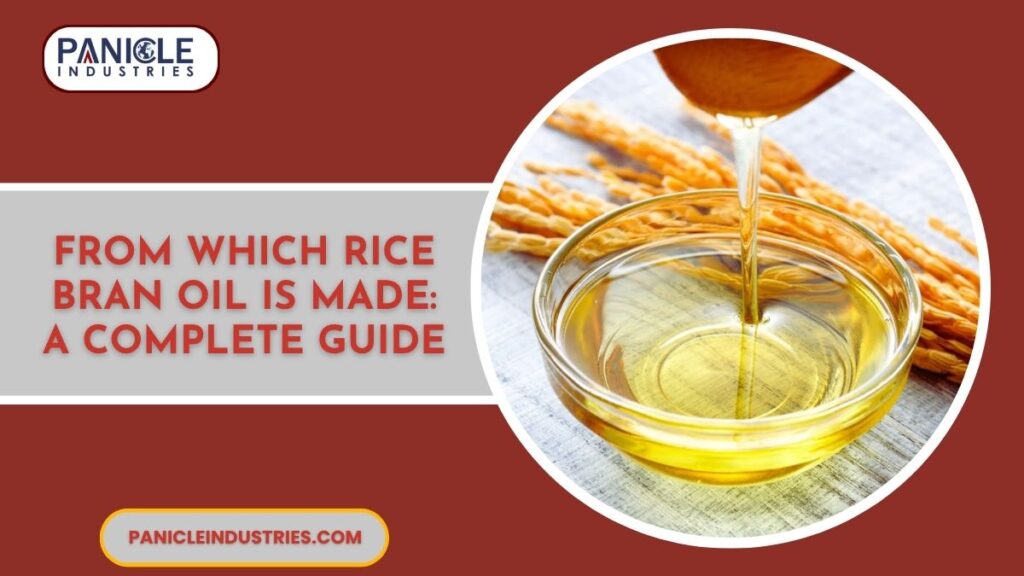Rice bran oil is gaining popularity as a healthy and versatile cooking oil. It is light, has a neutral taste, and is believed to have several health benefits. But many people wonder — from which rice bran oil is made? The answer lies in a specific part of the rice grain known as the “bran.” While rice is a common food staple across the world, not everyone is aware of how this nutritious oil is extracted from the rice grain.
In this blog, we will explain in simple and clear language where rice bran oil comes from, how it is made, and why it is considered a better choice for cooking. Let’s explore the journey of rice bran oil from the grain to your kitchen.
What Is Rice Bran Oil?
Rice bran oil is an edible vegetable oil that comes from the outer layer of the rice grain, known as rice bran. This oil is often praised for its light texture, high smoke point, and heart-friendly properties.
It is commonly used in:
- Cooking and frying
- Salad dressings
- Cosmetic products
- Pharmaceuticals
This oil is particularly popular in countries like India, Japan, and Thailand for daily cooking due to its balance of healthy fats and antioxidants.
Also read: Can Rice Bran Oil Be Used for Deep Frying
From Which Rice Bran Oil Is Made: Understanding the Source
Now let’s answer the main question: From which rice bran oil is made?
Rice bran oil is made from the bran layer of the rice grain — specifically from the husked rice, which includes three parts:
- Bran – the hard outer layer
- Germ – the small nutrient-rich core
- Endosperm – the starchy part (which we usually eat as white rice)
The oil is extracted from the rice bran, which is a by-product of the rice milling process.
What Is Rice Bran?
Rice bran is the outer brown layer of the rice grain that is removed during the milling process to produce white rice.
It is rich in:
- Dietary fiber
- Essential fatty acids
- Vitamins (especially B and E)
- Minerals and antioxidants
Even though it’s removed before cooking rice, the bran is extremely valuable for oil production.
How Is Rice Bran Oil Extracted?
Here’s how rice bran oil is made, step by step:
Step 1: Collection of Rice Bran
After the rice is milled and polished to make white rice, the outer bran layer is collected separately.
Step 2: Stabilization
Fresh rice bran is quickly stabilized using heat to prevent it from spoiling. Rice bran contains natural enzymes that can break down the oil quickly if not treated.
Step 3: Oil Extraction
The stabilized rice bran goes through mechanical pressing or solvent extraction (using a food-grade solvent like hexane) to separate the oil from the bran.
Step 4: Refining
The extracted crude oil is then refined to remove impurities, smell, and color. The final result is a light-colored, neutral-tasting oil perfect for cooking.
Types of Rice Used for Rice Bran Oil
Rice bran oil can be extracted from most varieties of rice, but the most common ones are:
- Long-grain rice
- Medium-grain rice
- Short-grain rice
Each variety may produce slightly different oil in terms of color and flavor, but they are all suitable for oil extraction.
Nutritional Benefits of Rice Bran Oil
Because rice bran oil is extracted from the nutrient-rich outer layer, it retains several healthful components:
1. Rich in Antioxidants
It contains oryzanol, a powerful antioxidant known for improving heart health and lowering cholesterol.
2. Balanced Fat Composition
Rice bran oil contains a healthy balance of:
- Monounsaturated fats (MUFA)
- Polyunsaturated fats (PUFA)
- Saturated fats (lower amount)
This makes it a heart-friendly option compared to oils high in saturated fat.
3. Contains Vitamin E
Vitamin E helps keep skin healthy and supports the immune system.
4. High Smoke Point
Ideal for deep frying and high-temperature cooking without producing harmful compounds.
Why Use Rice Bran Oil in Cooking?
Here are a few reasons why rice bran oil is ideal for cooking:
- Neutral flavor that doesn’t overpower food
- Stable at high temperatures
- Light texture, non-greasy feel
- Suitable for all types of cooking: stir-frying, deep-frying, sautéing, and baking
Environmental Benefits of Rice Bran Oil
Rice bran oil also supports sustainability. Here’s why:
- Uses a by-product of rice milling (reduces food waste)
- Promotes full use of the rice crop
- Offers economic value to rice-producing regions
By using a waste product, rice bran oil contributes to more efficient farming and manufacturing practices.
Countries That Produce Rice Bran Oil
Rice bran oil is widely produced in countries with high rice consumption and production:
- India – one of the largest consumers and exporters of rice bran oil
- Japan – uses it in both food and beauty products
- Thailand – a major producer due to abundant rice farming
- China, Vietnam, and Indonesia – also produce rice bran oil in large volumes
How to Identify Pure Rice Bran Oil
When buying rice bran oil, look for the following signs of quality:
- Labeled as 100% pure rice bran oil
- Cold-pressed or expeller-pressed (if available)
- Light yellow color and mild aroma
- No additives or preservatives listed on the label
Brands that mention high oryzanol content are usually good choices for health-conscious buyers.
Uses of Rice Bran Oil Beyond Cooking
Besides being used in the kitchen, rice bran oil has many other uses:
1. Skincare
- Moisturizes dry skin
- Reduces fine lines and wrinkles
- Helps soothe inflammation
2. Haircare
- Strengthens roots
- Adds shine to hair
- Controls frizz and dryness
3. Industrial Uses
- Used in soaps, candles, and massage oils
- Also used in the preparation of dietary supplements
Comparison with Other Oils
How does rice bran oil compare with other cooking oils?
| Oil Type | Smoke Point | Health Benefits | Flavor |
|---|---|---|---|
| Rice Bran Oil | 450°F | Heart health, cholesterol | Neutral |
| Olive Oil | 375°F | Antioxidants, skin health | Distinct |
| Sunflower Oil | 440°F | Vitamin E | Light |
| Mustard Oil | 480°F | Rich in Omega-3 | Strong taste |
As shown, rice bran oil is a balanced choice for those looking for a healthy and versatile cooking oil.
Tips for Storing Rice Bran Oil
To maintain the freshness of your rice bran oil:
- Keep it in a cool, dark place
- Store in an airtight bottle
- Avoid exposure to heat and sunlight
- Use within 6 months of opening
Conclusion
Now that you know from which rice bran oil is made, it’s clear that this healthy oil has a humble yet powerful origin — the outer layer of the rice grain. Extracted from the rice bran, it is full of beneficial nutrients and serves as a smart choice for everyday cooking. Whether you’re frying, baking, or just sautéing, rice bran oil’s high smoke point and light flavor make it extremely versatile. Beyond the kitchen, it also finds uses in skincare and wellness products. So, next time you reach for a bottle of cooking oil, remember the journey it took — from rice grain to golden goodness in your kitchen.


